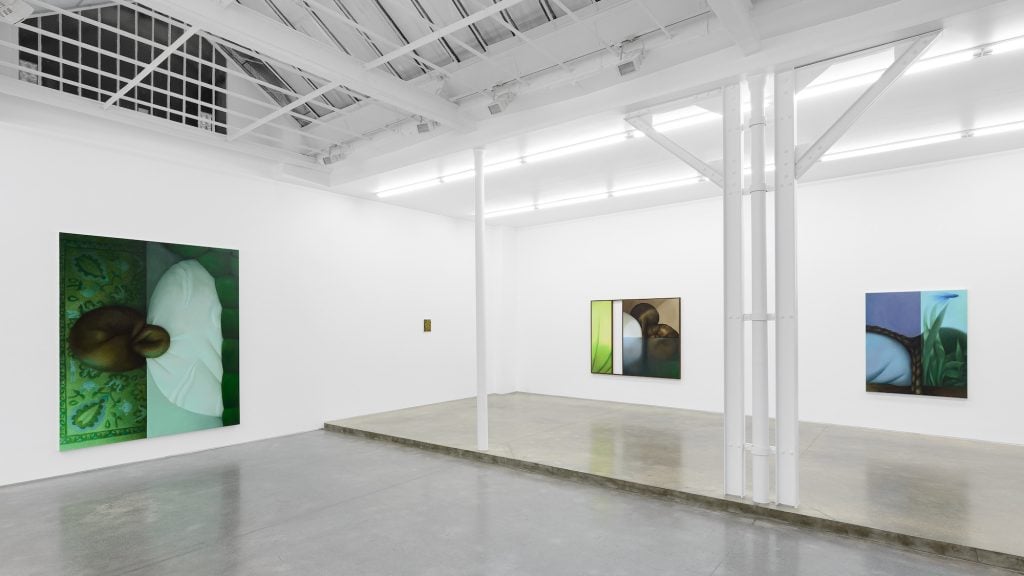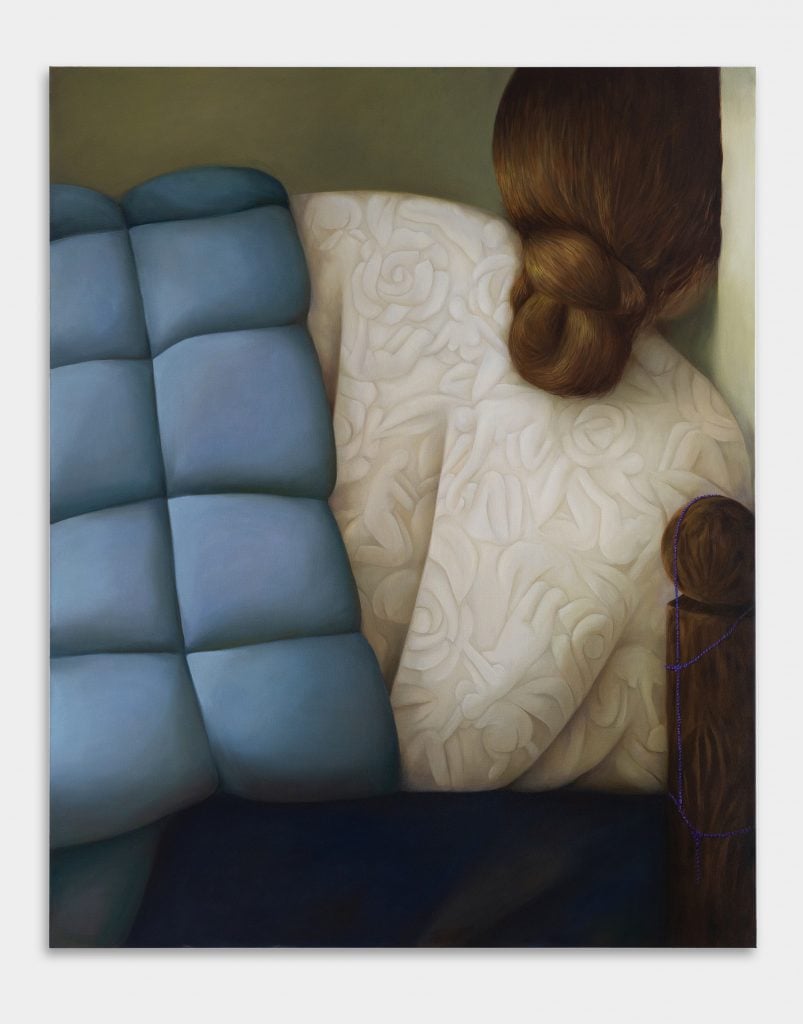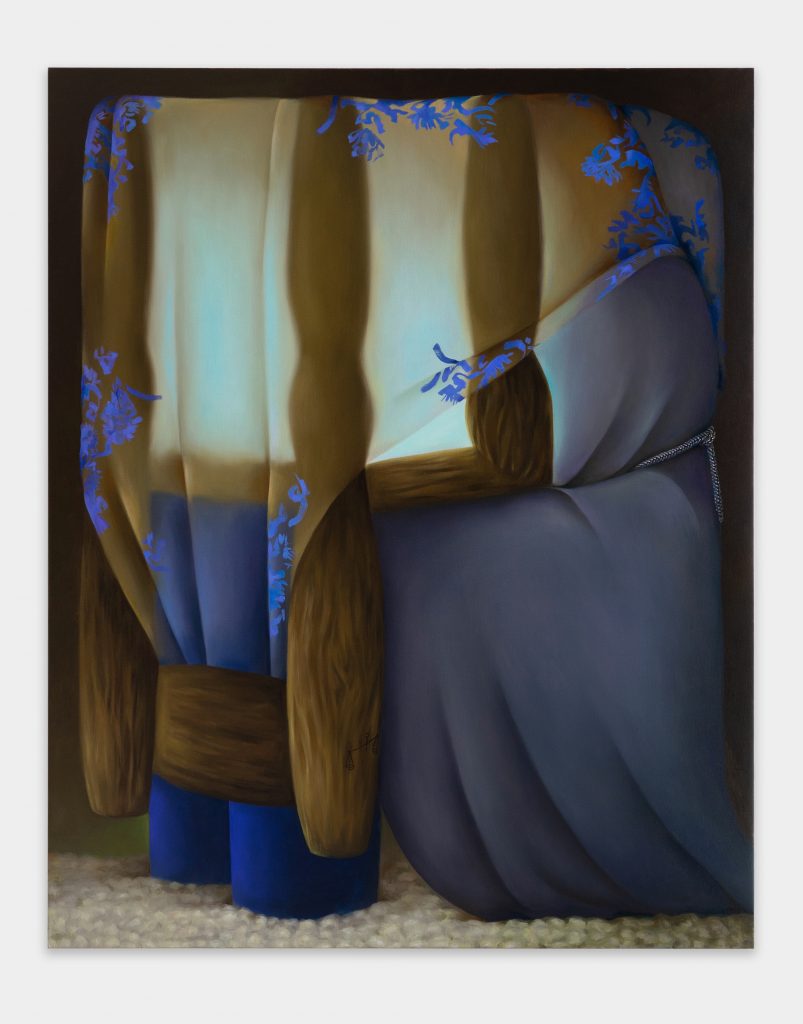Time holds its breath in the paintings of Diane Dal-Pra. The women, motionless and silent like the decor that surrounds them, are seen from behind, revealing only their long braided hair. A woman has laid her head in – or possibly behind – an aquarium. We can’t quite say. Another put her head inside a glowing lampshade. In yet another, Dal-Pra depicts a woman seated from above, who has planted her face flat against a table. The white lace is carefully draped over the crown of her braided bun, like an oppressive wedding veil. We think of Sylvia Plath’s head in an oven, as well as a kind of letting go or abandonment.
Yet Dal-Pra’s works do not depict any specific narrative. Instead, these sturdy, broad-shouldered women, whose elements she zooms in on, convey a sense of silent brewing, internal struggle, as well as the physical urge to take refuge, as a means of coping. The furniture and textiles often depicted by the artist may also contain life beneath their surface. On closer inspection, patterns on a rug or fabric reveal the bodies of women in active motion or on all fours. The fragile silhouette of a fly could also appear inside a lampshade, before falling to join a pile of dead comrades below.

Installation view “Remaining Parts” 2022. Courtesy of Galerie Derouillon.
The French painter (b. 1991) draws on her distorted dreams and memories to construct her large oil paintings which, like dreams, leave us with unexplained overarching impressions, which don’t quite make logical sense. Set in intimate, lamp-lit interior scenes of everyday domestic life, these works border on magical realism. Dal-Pra’s skill in painting moments suspended between states gives this meaning: she paints the air of a room, heavy with humidity, translucent gauze fabrics hanging over faces or droplets of water about to fall out of a drooping braid.
“I really like this tension that exists between things that are about to fall or arise so that it creates a relationship to time, in which time has already done its job,” said Dal-Pra of his studio in the north of Paris. “That tense moment just before the denouement, when something else is going to happen, but everything is still possible, and nothing has been decided yet, it’s the moment that gives the most adrenaline, the most possibilities,” she said.
For Dal-Pra too, it seems like anything is possible right now. The artist had his first solo gallery exhibition in 2020 and has already captured the imagination of a cohort of international institutions and collectors. Her work entitled “Slow cold fire” is currently included in LGDR’s “Rear View”, the inaugural group exhibition of the gallery’s New York flagship where she is shown alongside modern masters including Félix Vallotton, René Magritte (with whom she is sometimes compared), Francis Bacon, as well as contemporaries including Seth Becker, Francesco Clemente and Urs Fischer.
This exhibition marks a milestone in the rising artist’s career, following critically acclaimed presentations with Massimo de Carlo in London in 2021, and with Galerie Derouillon during Paris + by Art Basel in 2022 (she is represented by the two galleries). These two exhibitions led to institutional acquisitions such as the Louis Vuitton Foundation (Paris), the Yuz Museum Shanghai and the Institute of Contemporary Art Miami, among others.

Diane Dal-Pra, The Other Room (2021). Courtesy of Massimo De Carlo.
“Our main concern is to place Diane’s work in institutional collections so that she can have greater visibility,” said Marion Coindeau, director of Galerie Derouillon. The demand for Dal-Pra’s paintings, coupled with the slowness with which she produces works, has resulted in long wait times for paintings now ranging from $50,000 to $140,000, according to her galleries.
“She takes forever to do a painting, and that’s part of their beauty because she works on the same detail for days,” said Ludovica Barbieri, partner at Massimo de Carlo. “She has a long career ahead of her,” she added, noting, “They also really like her work in Asia. But the thing is, we don’t have enough boards for all the requests.
When we caught up with Dal-Pra she was busy working on her work for the LGDR exhibition as well as several others planned for an upcoming solo exhibition at Mostyn, a public art gallery in North Wales, in July . “It’s interesting for me to build a series of paintings over a longer period, and to move from one painting to another, so that they evolve together. I find it more cohesive,” she said of her slower method. These recent works draw inspiration from literature, photography and cinema, particularly in their compositional framework, as well as from the Renaissance.
“It’s as if time is shrinking, and I have a completely different relationship to the passage of time,” she says. “The act of painting is so encompassing, which is why I love it. It involves the whole body, our attention and our being.
Dal-Pra paints can have a similar effect. His works “appeal to all the senses, including our sense of touch,” Coindeau said, “there is a lot of texture [in the recurring representations of fabric], and the sound, even. atmospheres [of the paintings] are very muffled and felted, giving the impression of a reigning silence. In these paintings, women often appear wrapped in thick blankets, with their heads resting on a pillow or covered in fabric. Such works are inspired by Dal-Pra’s own battles with insomnia and the semi-conscious state she associates with it.

Diane Dal Pra, midnight troubles (2021). Courtesy of Massimo de Carlo.
“The whole challenge is to create sensory atmospheres that are not visual at all,” Dal-Pra explained. For her latest series, that atmosphere was achieved through “a move towards fewer elements, a reduction, but with more weight,” in the subjects, she said. While female bodies may still be larger than life, increasingly “they are suggested only by a gestural and floating presence, as if dissipating, and objects become all that remains of our mark on the things,” she said.
Other works have no human presence and may depict fabrics draped or tied over furniture and carved wooden bed frames. These inanimate materials seem to hum and swell as if they were living protagonists themselves.
Dal-Pra can be superstitious about objects in her daily life, to which she attributes a broader meaning. This resonates in her subjects, such as with the long, braided, bundled hair she often depicts. Years after losing her mother at the age of 17, the artist came across her mother’s hairbrush, with strands of hair curled between her teeth. “I only saw the connection recently, but the objects took on a completely different meaning after he died, and it was pretty amazing to tell me that his hair was the only thing left,” she said. .
Her mother also manifests herself, says the artist, in her “need to tell stories related to women”.
Dal-Pra was not born into an artistically inclined family, per se. His mother worked in the pharmacy and his father in construction. But still, she doesn’t remember a time when she didn’t have a pencil or pencil in her hand. In college, Dal-Pra did not pursue fine art, instead studying art history and applied arts. She had just started working as an artistic director in Bordeaux four years ago when she suddenly stopped and started painting.
“There are things you can’t let go,” she says of her decision to move to Paris to become a painter. “I didn’t want painting to just be my Sunday hobby – it just wasn’t possible,” she said.
In 2019, she won the Laureate prize from the Artists’ Collecting Society, which earned her a residency at the Palazzo Monti, in Italy. Shortly after, the independent artistic director Nicolas Poillot put her in touch with the Galerie Derouillon. “We really felt there was potential, and it was the start of something,” Coindeau said of the first studio visit with Dal-Pra and gallery founder Benjamin Derouillon. She was offered a 2020 Paris exhibition, curated by Poillot, which set the relationship in motion.
As for Massimo de Carlo, Barbieri said he discovered Dal-Pra’s work on Instagram during the pandemic. “I didn’t know anything about the artist. Totally out of the blue, I saw an image and loved it,” she said. Barbieri purchased one of Dal-Pra’s paintings through Derouillon, although she had to wait nine months to see it in person, due to pandemic restrictions.
Having not gone down the traditional route of art school, Dal-Pra admits that a bit of “imposture syndrome” may be behind at least some of his highly technical and realistic experiences with oil painting. “I love challenging myself to paint transparency. It’s exciting to figure out how to do it right,” she said. Dal-Pra’s signature, translucent surfaces are indeed a deft marvel. She sometimes works with an iPad as a composition tool. She photographs her paintings in progress, testing the effects of changing light and composition on the digital image of the work, before continuing her painting. The reason, she explained, is due to her slow oil painting process, which does not forgive experimentation directly on canvas.
In his studio, Dal-Pra had recently been working on painting a steamy window pane, like a steamy bathroom, with a figure behind it. Above it was a quick, gestural shape as if it had been scribbled on the wet surface by a finger. It had been her first attempt at the subject, and she had pulled it off with astonishing skill.
“The hardest part is finding the right touch, knowing when to stop and not going overboard,” Dal-Pra said, lest the glass and its wet translucency become impenetrable.
Follow Artnet News on Facebook:
Want to stay one step ahead of the art world? Subscribe to our newsletter to receive breaking news, revealing interviews and incisive reviews that move the conversation forward.
